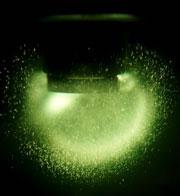 Imploding bubbles, caught on film emitting light. Taleyarkhan claims they emit energy from fusion too.Credit: D. Flannigan and K.S. Suslick, University of Illinois at Urbana-Champaign
Imploding bubbles, caught on film emitting light. Taleyarkhan claims they emit energy from fusion too.Credit: D. Flannigan and K.S. Suslick, University of Illinois at Urbana-ChampaignNuclear engineer Rusi Taleyarkhan's claims that he had achieved table-top fusion in collapsing bubbles caused a storm when they were first reported in Science in 2002. If the effect is real, and could be harnessed, it might one day provide an almost limitless source of energy.
Four years later, Taleyarkhan's work retains an almost magical ability to grab the headlines, most recently in January, when his latest claims were promoted in a press release by the American Physical Society, and Science defended its initial publication of the work in an editorial as recently as 3 March. Millions of dollars are being spent trying to repeat the work, including $800,000 from the US Department of Defense. But corroboration remains elusive.
Taleyarkhan and his co-authors vigorously affirm that the effect they have seen is real, and have published several further positive studies - most recently in Physical Review Letters, in which they claim to have countered previous technical objections to their work.
Yet there has been no independent confirmation of their results, and an investigation by Nature of the circumstances surrounding the experiments reveals serious questions about their validity. Interviews with researchers who have worked closely with Taleyarkhan at Purdue University in the past two years, a re-analysis of his data by a group critical of him, as well as a review by the US patent office, suggest that serious doubts are prevalent in the physics community.
Purdue University did not promote Taleyarkhan's most recent paper to the media. This may reflect the fact that other faculty members at the university, who are trying to repeat the work, have been concerned by Taleyarkhan's actions since he arrived there full-time in 2004. The steps he has taken, they say, include claiming positive results from equipment on which they had seen only negative data, before removing the equipment from their lab altogether (see 'Is bubble fusion simply hot air').
Brian Naranjo of the University of California, Los Angeles, has now completed an analysis suggesting that the spectrum reported in Taleyarkhan's latest paper as proof of nuclear fusion came instead from the radioactive decay of standard lab material (see 'Bubble bursts for table-top fusion').
ADVERTISEMENT
And the US Department of Energy, for whom Taleyarkhan was working when he first reported his claims, has abandoned its patent application relating to bubble fusion, after the patent office said it would throw it out last year (see 'A sound investment?').
Taken together, the overall message from many people close to this work is that there is no longer any hope that this line of publications will yield a viable fusion energy source. For some this is almost liberating: those sticking with bubble fusion are freer than ever to explore other approaches to it, or to try other kinds of studies on acoustic chambers and the behaviour of collapsing bubbles. For others it is now the end of bubble fusion. There are other kinds of science to be done.
Post a comment to this story by visiting our fusionsilencingthehy.html">newsblog .
